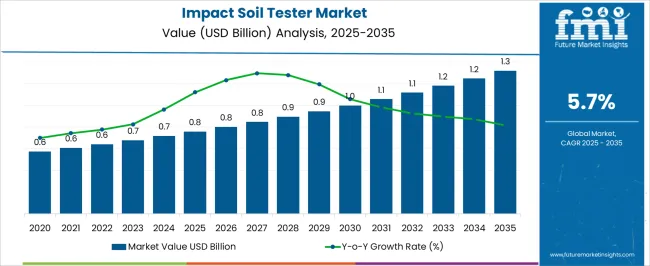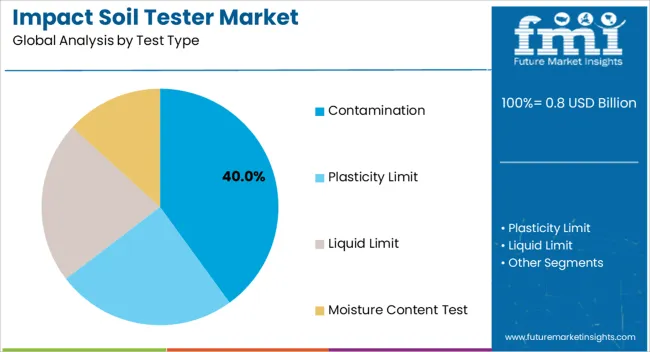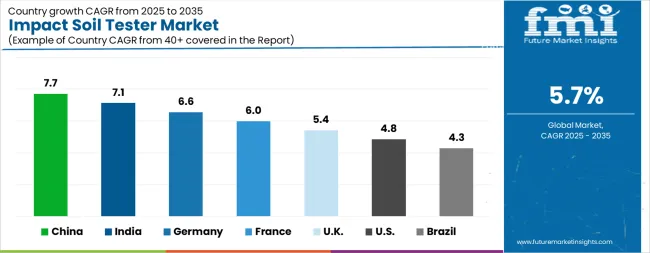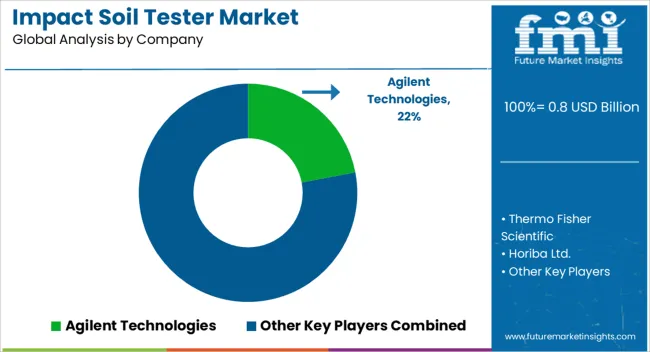The Impact Soil Tester Market is estimated to be valued at USD 0.8 billion in 2025 and is projected to reach USD 1.3 billion by 2035, registering a compound annual growth rate (CAGR) of 5.7% over the forecast period.

| Metric | Value |
|---|---|
| Impact Soil Tester Market Estimated Value in (2025 E) | USD 0.8 billion |
| Impact Soil Tester Market Forecast Value in (2035 F) | USD 1.3 billion |
| Forecast CAGR (2025 to 2035) | 5.7% |
The Impact Soil Tester market is witnessing steady expansion driven by increasing concerns about soil health and environmental sustainability. The current market scenario reflects rising awareness among governments, research organizations, and industries regarding soil contamination and its impact on agriculture, construction, and environmental restoration projects. In 2025, contamination testing is expected to account for a significant portion of the market, as soil degradation and pollutant accumulation continue to be prioritized in environmental assessments.
Additionally, the growing investments in infrastructure development and green initiatives have further supported the demand for advanced soil testing solutions. The integration of soil testing with regulatory frameworks for environmental protection and risk management has accelerated adoption across industries.
Looking ahead, the market is expected to benefit from innovations in sensor technology, data analysis, and portable testing equipment that allow faster and more accurate soil assessments The increasing focus on sustainable land management practices and stricter compliance mandates is anticipated to drive long term growth, providing opportunities for further deployment of soil testing solutions across agriculture and environmental science sectors.
The impact soil tester market is segmented by test type, industry/end use, and geographic regions. By test type, impact soil tester market is divided into Contamination, Plasticity Limit, Liquid Limit, and Moisture Content Test. In terms of industry/end use, impact soil tester market is classified into Environmental Science, Mining, Construction, Agriculture, and Sports. Regionally, the impact soil tester industry is classified into North America, Latin America, Western Europe, Eastern Europe, Balkan & Baltic Countries, Russia & Belarus, Central Asia, East Asia, South Asia & Pacific, and the Middle East & Africa.

The contamination test type segment is expected to hold 40.00% of the revenue share in the Impact Soil Tester market in 2025, making it the leading test type. This prominence is attributed to the rising concerns about pollutants in soil due to industrial waste, agricultural runoff, and improper disposal of hazardous materials. Soil contamination testing is being prioritized to assess and remediate the adverse effects of chemicals, heavy metals, and other contaminants that impact crop yield and groundwater safety.
The segment’s growth has been driven by the need for quick and reliable methods of detecting contaminants, particularly in areas where human health risks and environmental liabilities are increasing. Portable and field deployable testing solutions are being integrated with advanced analytical tools to provide actionable insights in real time.
Regulatory requirements for environmental protection and soil rehabilitation programs have further supported the demand for contamination testing As awareness regarding soil pollution continues to rise, the contamination test type segment is expected to remain at the forefront, with a focus on enhancing detection accuracy and expanding testing capabilities.
The environmental science industry segment is projected to account for 35.00% of the revenue share in the Impact Soil Tester market in 2025, establishing it as the largest end use industry. The leadership of this segment is being driven by the growing demand for soil quality monitoring in research institutions, government agencies, and environmental consulting firms. Soil testing is being increasingly integrated into environmental impact assessments, restoration projects, and long term land management strategies.
The segment has benefited from rising global investments in sustainable development and conservation initiatives aimed at preserving ecosystems and mitigating pollution. Scientific research focused on soil composition, microbial activity, and contamination pathways has further increased the reliance on advanced soil testing solutions.
The need for accurate and efficient soil analysis tools is being recognized as critical for ensuring environmental compliance and safeguarding public health The environmental science segment is expected to maintain its dominant position as academic research, environmental monitoring, and regulatory enforcement continue to expand their reliance on data driven soil testing methods to support sustainable land use and ecological resilience.
Impact soil tester is used to control and measure strength of the soil and its consolidation level. It is commonly used to indicate degree of compaction of soil used during construction of the road. Furthermore, Impact Soil testers are also used to identify poorly compacted areas and ineffective composition of the material.
End users commonly prefer Non-destructive Impact soil tester techniques for analysing the superiority of the soil. Non-destructive testers are always preferred as these don’t alter the sample/material while the test is being performed on the same.
Attributing to the high investments in construction industry in various regions across the globe, significant growth is expected in impact soil tester market. Impact soil testers are used very frequently during the construction of the building or any structure to understand competency of soil for proposed construction work.
Hence, there is high demand for impact soil testers around the globe, manufacturers are focusing on launching newly-upgraded Impact soil testers having the capability to identify the quality of the soil precisely and accurately. There is a massive demand for impact soil testers in industries such as agriculture, construction, and mining, which drives the growth of the impact soil testers market.

| Country | CAGR |
|---|---|
| China | 7.7% |
| India | 7.1% |
| Germany | 6.6% |
| France | 6.0% |
| UK | 5.4% |
| USA | 4.8% |
| Brazil | 4.3% |
The Impact Soil Tester Market is expected to register a CAGR of 5.7% during the forecast period, exhibiting varied country level momentum. China leads with the highest CAGR of 7.7%, followed by India at 7.1%. Developed markets such as Germany, France, and the UK continue to expand steadily, while the USA is likely to grow at consistent rates. Brazil posts the lowest CAGR at 4.3%, yet still underscores a broadly positive trajectory for the global Impact Soil Tester Market. In 2024, Germany held a dominant revenue in the Western Europe market and is expected to grow with a CAGR of 6.6%. The USA Impact Soil Tester Market is estimated to be valued at USD 280.2 million in 2025 and is anticipated to reach a valuation of USD 449.8 million by 2035. Sales are projected to rise at a CAGR of 4.8% over the forecast period between 2025 and 2035. While Japan and South Korea markets are estimated to be valued at USD 41.1 million and USD 25.1 million respectively in 2025.

| Item | Value |
|---|---|
| Quantitative Units | USD 0.8 Billion |
| Test Type | Contamination, Plasticity Limit, Liquid Limit, and Moisture Content Test |
| Industry/End Use | Environmental Science, Mining, Construction, Agriculture, and Sports |
| Regions Covered | North America, Europe, Asia-Pacific, Latin America, Middle East & Africa |
| Country Covered | United States, Canada, Germany, France, United Kingdom, China, Japan, India, Brazil, South Africa |
| Key Companies Profiled | Agilent Technologies, Thermo Fisher Scientific, Horiba Ltd., PerkinElmer Inc., ABB Ltd., Emerson Electric Co., and Danaher Corporation |
The global impact soil tester market is estimated to be valued at USD 0.8 billion in 2025.
The market size for the impact soil tester market is projected to reach USD 1.3 billion by 2035.
The impact soil tester market is expected to grow at a 5.7% CAGR between 2025 and 2035.
The key product types in impact soil tester market are contamination, plasticity limit, liquid limit and moisture content test.
In terms of industry/end use, environmental science segment to command 35.0% share in the impact soil tester market in 2025.






Our Research Products

The "Full Research Suite" delivers actionable market intel, deep dives on markets or technologies, so clients act faster, cut risk, and unlock growth.

The Leaderboard benchmarks and ranks top vendors, classifying them as Established Leaders, Leading Challengers, or Disruptors & Challengers.

Locates where complements amplify value and substitutes erode it, forecasting net impact by horizon

We deliver granular, decision-grade intel: market sizing, 5-year forecasts, pricing, adoption, usage, revenue, and operational KPIs—plus competitor tracking, regulation, and value chains—across 60 countries broadly.

Spot the shifts before they hit your P&L. We track inflection points, adoption curves, pricing moves, and ecosystem plays to show where demand is heading, why it is changing, and what to do next across high-growth markets and disruptive tech

Real-time reads of user behavior. We track shifting priorities, perceptions of today’s and next-gen services, and provider experience, then pace how fast tech moves from trial to adoption, blending buyer, consumer, and channel inputs with social signals (#WhySwitch, #UX).

Partner with our analyst team to build a custom report designed around your business priorities. From analysing market trends to assessing competitors or crafting bespoke datasets, we tailor insights to your needs.
Supplier Intelligence
Discovery & Profiling
Capacity & Footprint
Performance & Risk
Compliance & Governance
Commercial Readiness
Who Supplies Whom
Scorecards & Shortlists
Playbooks & Docs
Category Intelligence
Definition & Scope
Demand & Use Cases
Cost Drivers
Market Structure
Supply Chain Map
Trade & Policy
Operating Norms
Deliverables
Buyer Intelligence
Account Basics
Spend & Scope
Procurement Model
Vendor Requirements
Terms & Policies
Entry Strategy
Pain Points & Triggers
Outputs
Pricing Analysis
Benchmarks
Trends
Should-Cost
Indexation
Landed Cost
Commercial Terms
Deliverables
Brand Analysis
Positioning & Value Prop
Share & Presence
Customer Evidence
Go-to-Market
Digital & Reputation
Compliance & Trust
KPIs & Gaps
Outputs
Full Research Suite comprises of:
Market outlook & trends analysis
Interviews & case studies
Strategic recommendations
Vendor profiles & capabilities analysis
5-year forecasts
8 regions and 60+ country-level data splits
Market segment data splits
12 months of continuous data updates
DELIVERED AS:
PDF EXCEL ONLINE
Impact Resistant Glass Market Forecast Outlook 2025 to 2035
Impact Testing Machine Market Size and Share Forecast Outlook 2025 to 2035
Impact Modifier Market Growth & Trends 2018-2028
High Impact Corrugated Boxes Market Analysis - Size, Share, and Forecast Outlook 2025 to 2035
Incline Impact Tester Market Size and Share Forecast Outlook 2025 to 2035
Automatic Impact Testing Machine Market Size and Share Forecast Outlook 2025 to 2035
PVC-M High Impact Resistant Water Supply Pipe Market Size and Share Forecast Outlook 2025 to 2035
Automotive Door Impact Bars Market
Automotive Crash Impact Simulator Market Size and Share Forecast Outlook 2025 to 2035
Anderson Cascade Impactor Market Size and Share Forecast Outlook 2025 to 2035
On Purpose Technologies Market Growth - Trends & Forecast 2025 to 2035
Soil Erosion Testing Market Size and Share Forecast Outlook 2025 to 2035
Soil Health Nano-Sensors Market Analysis - Size, Share, and Forecast Outlook 2025 to 2035
Soil Moisture Sensor Market Size and Share Forecast Outlook 2025 to 2035
Soil Aerators Market Size and Share Forecast Outlook 2025 to 2035
Soil Hardening Agent Market Size and Share Forecast Outlook 2025 to 2035
Soil Field Testing Equipment Market Growth - Trends & Forecast 2025 to 2035
Soil Testing Market Growth - Trends & Forecast 2025 to 2035
Soil Stabilization Material Market Outlook 2025 to 2035
Soil Testing Kit Market Growth - Trends & Forecast 2025 to 2035

Thank you!
You will receive an email from our Business Development Manager. Please be sure to check your SPAM/JUNK folder too.
Chat With
MaRIA